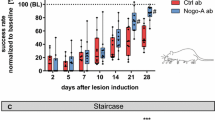Abstract.
We characterized the early effects of anti-very late antigen (VLA-4) and its counterligand vascular cell adhesion molecule-1 (VCAM-1) antibody therapy on T cell infiltration and apoptosis in adoptive transfer experimental autoimmune neuritis of female Lewis rats. At the peak of disease, animals were treated with anti-VCAM-1 monoclonal antibody (mAb), anti-VLA-4 mAb, or the respective isotype mAb controls 18, 12, or 6 h before perfusion. Anti-VCAM-1 led to a rapid, significant increase of apoptotic T cells in the sciatic nerve with a maximum after 6 h, preceding the significant decrease of T cell infiltration seen after 18 h. This was accompanied by a significant reduction in mRNA levels for IFN-γ and inducible nitric oxide synthase. The results for anti-VLA-4 treatment showed a similar trend. The early increase of T cell apoptosis following disruption of VLA-4/VCAM-1 interaction may reflect a novel signaling component of proapoptotic pathways.
Similar content being viewed by others
Author information
Authors and Affiliations
Additional information
Revised, accepted: 10 July 2001
Electronic Publication
Rights and permissions
About this article
Cite this article
Leussink, .V., Zettl, .U., Jander, .S. et al. Blockade of signaling via the very late antigen (VLA-4) and its counterligand vascular cell adhesion molecule-1 (VCAM-1) causes increased T cell apoptosis in experimental autoimmune neuritis. Acta Neuropathol 103, 131–136 (2002). https://doi.org/10.1007/s004010100444
Received:
Issue Date:
DOI: https://doi.org/10.1007/s004010100444




